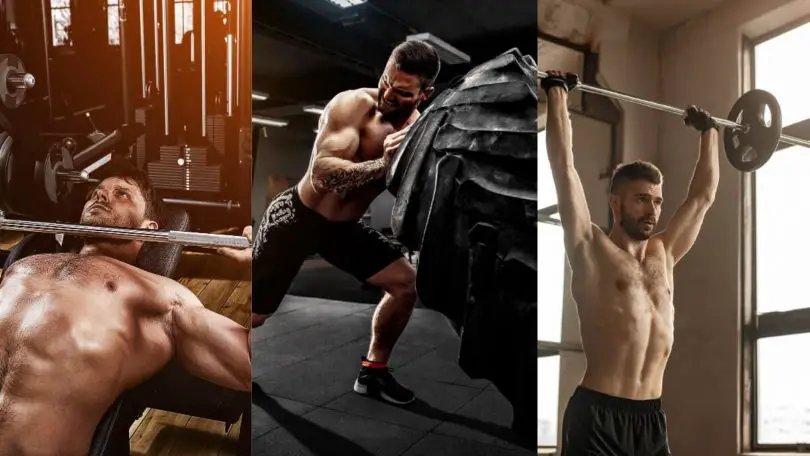Arnold Split vs PPL
The Classic Arnold split! No 6-day workout split will deliver results like this time-tested routine. This type of training is also known as agonist/antagonist training, and was the preferred method of Arnold Schwarzenegger’s (and many other 70s bodybuilders) workouts.
Arnold Schwarzenegger used this workout plan to achieve all he did in his bodybuilding career; you can do the same if you try. If you have the time and dedication to commit yourself to a 6-day bodybuilding routine, look no further!
To get the most out of this routine, make sure you’re eating plenty of food and getting enough sleep to ensure adequate rest. This level of volume and frequency is taxing.
6-day workout splits keep you in the gym almost all week. This high-frequency training allows you to hit each muscle several times throughout the week. As a result, you are likely to see some of the best benefits of your life!
It’s important that you follow a well-designed routine when committing to such a high volume and frequency of training. Winging it often leads to muscle imbalances, burns and injury.
The Arnold split routine is great for saving time and building overall strength. But if your goals are hypertrophy and aesthetics, your muscles will benefit from a more focused attention. The Arnold split goes like this;
Day 1 – Chest and Back
Day 2 – Shoulders and Arms
Day 3 – Legs and Lower Back
With this setup, you can work complimentary muscle groups on any given day, while giving others time to rest and recover. This is truly a genius setup!
Sampling plan
While this worked out great for Arnold, his ability to perform at high intensity and very high volumes with little rest meant that this workout would be counter-productive for the average trainee.
The muscle groups that respond best to antagonist supersets are the biceps and triceps, with the biceps and triceps being the most popular to train in this fashion.
Here’s a sample workout to try that will promote both strength and size gains:
Day 1 – Chest and Back
Chest
- Bench Press
- Incline Bench Press
- Dumbbell Pullover
Back
- Bent-Over Barbell Rows
- Deadlift
Abs
- crunches
Day 2 – Shoulders and Arms
Shoulders
- Barbell Clean and Press
- side lateral raises
- Standing T-Bar Row
- Military Press
Arms
- Standing Barbell Curls
- Seated Dumbbell Curls
- Close the grip bench
- Standing Barbell Tricep Extension
Forearms
- Wrist Curls
- Reverse Wrist Curls
Abs
- Reverse crunch
Day 3 – Legs and Lower Back
Legs
- Squat
- Lunge
- Leg Curls
Lower back
- Stiff Leg Deadlift
- good morning
Calves
- Standing calf raise
Abs
- crunches
What are the benefits?
-
Less exercise time.
By working together two opposing muscles, such as the chest and back, you will always be able to do more total work in a given amount of time, as opposed to doing straight sets.
For busy people who want to maximize the hours they spend at the gym, this is invaluable.
-
Muscular Balance
Another benefit of the Arnold split is effective for maintaining muscle balance in the joint.
Many people develop serious injuries from unbalanced training. If we analyze the training logs of most people in the gym, we probably see a significant amount of work of the chest, shoulders and quadriceps, with a smaller range of back and posterior chain to support.
-
Increased Strength
The opposing superset has been used for years as a viable method for developing strength.
- First, by alternately contracting opposing muscle groups, you can often increase motor unit recruitment.
- Second, strength development requires a lot of quality sets. By alternating, you can do more things in a given amount of time.
- Alternating sets – When you maximally activate a muscle group, the antagonist muscle group is inhibited to allow more force into the agonist. Through inhibition, you allow that muscle to restore its strength much faster.
-
Better Pump
One of the reason Arnold preferred to train opposing body parts together was because he believed that the combined pumping of two muscles in one area creates a flow in a physique that you can’t achieve with a single-set training.
Another advantage of pumping opposing body parts is that it makes the training of the agonist feel ‘better’.
Arnold Split Cons
- Fatigue is a little harder to manage.
- Can be limited to specific adaptations such as maximum power, and this point circles back to the fatigue aspect.
- Usually low weekly training frequency.
What you should look out for in the Arnold split
-
Lower back safety
When engaging antagonistic muscle groups, one thing you need to pay attention to is the total load that a combination will place on the lower back.
-
Take proper rest
The opposing supersets popularized the way Arnold made them include no rest periods between each pair. However, we have found that incorporating rest intervals is more beneficial for developing strength and maintaining load.
Who should use the Arnold Split In Arnold split vs ppl?
Arnold split is an excellent training split that can be used by intermediate and advanced trainees, but it’s not ideal for beginners, who will do better with a full-body workout three times per week.
Beginners will use lighter weights and recover quickly, so it makes sense to work the whole body on a somewhat, more frequent basis. But as you get stronger, and the weight you’re using becomes heavier, recovery will become a problem. So, after you’ve been training for some time and made some decent gains in strength and size, you’ll probably find that you’ll make better sustained progress if you switch to doing the upper/lower split.
But you can go straight to splitting the opposing muscle groups if you want.
Just apply it diligently and consistently, eat a good muscle-building diet that has extra calories and plenty of protein, take some proven supplements, and make sure you get enough rest and sleep. Best wishes.
We can’t guarantee you’ll look like Arnold, but you can experience some of the best pumps and results you’ve had in a long time. Time is our most precious commodity.
Push/Pull/Legs (PPL) Workout Routine
Push/pull/legs is the preferred training split with pushing muscles (chest, shoulders, triceps), pulling muscles next (back, biceps, forearms, abs), and lower body (quads, hamstrings, glutes, calves w/ abs) the next Day. Add in rest days where needed while you don’t miss any days. 6 days a week is plenty, but you will add maximum muscle mass and strength.
Example workout structure:
- Monday: Chest, Shoulders & Triceps
- Tuesday: Back, Biceps, Abs and Forearms
- Wednesday: Legs
- Thursday: Chest, Shoulders and Triceps
- Friday: Back, Biceps, Abs and Forearms
- Saturday: Legs
- Sunday: Rest
If you choose the six-days-per-week option, be wise about your training intensity and exercise selection. You’re still hitting each muscle twice per week and leaving enough time between sessions for those muscles to recuperate and prepare for the next session.
Push, Pull, Legs Workout Split Example
- Monday: Push
- Tuesday: Pull
- Wednesday: Legs
- Thursday: Rest
- Friday: Push
- Saturday: Pull up
-
Sunday: Legs
Benefits of Push, Pull, Legs
- Emphasis on training specific muscles.
- Sufficient recovery time.
- The push/pull/legs split allows for easy programming of individual workouts as you have fewer muscles in each workout. In essence, you are splitting your upper training into two workouts.
Cons of push, push, leg
- More time at the gym.
- Requires more equipment.
- It can be a little more difficult to schedule your weekly training.
Who Should Use the Push/Pull/Legs Split in the Arnold split vs ppl?
Both intermediate and advanced trainees can use this split.
More specifically, though, if you’re just starting out or haven’t found much in the way of results for your efforts so far, you’ll certainly do best with the Arnold split workout routine. Stick with it for at least six months – more if you’re still making good progress.
What are your current goals?
The first and most important aspect to consider is deciding what your current goal is. The more specific goals are in nature, the more specific the program will be required.
What’s realistic with your lifestyle?
Unfortunately, not all of us have hours to spend at the gym, which brings up the topic of choosing what’s realistic for your lifestyle.
Not every program will fit perfectly into every lifestyle, and the formations will likely have an ups and downs at various points in your life. This is why it is important not to marry one structure and experiment with different styles of training.
Many times, when this aspect is not taken into account, this change will come naturally from feeling “burned out” while performing a style of training in daily life.
Other Factors to Consider on the Arnold split vs ppl
In general, if the goal is hypertrophy and strength, training one muscle group with intermediate and high intensity twice per week is a safe bet for progress—regardless of the program being started
Final Thoughts on Arnold split Vs PPL
Find the Best Workout Split for You in Arnold split vs ppl
Let’s get it out of the way! There are many effective training divisions. The second most effective divisions are those that support your goals and that you follow through.
No matter if you’re a bodybuilder or a powerlifter, there are many proven exercises, set-and-reps plans and training techniques, but ultimately find one that works for your goals, schedule, current fitness level, experience, etc.
When starting a new routine, keep the following in mind:
- Training Experience
- Target
- Your availability
- Your need for rest and recovery
- Your Weaknesses
- Your Age
The key to muscle growth is progressive overload. A beginner’s strength routine, with proper supporting work for bodybuilding purposes, can yield some quick gains. This will help you build a base, and make you more efficient, as you transition to a bodybuilding split. At most you’ll spend a few months in the beginner routine, and it will really help you become more effective at executing lifts and help you learn your limits.







